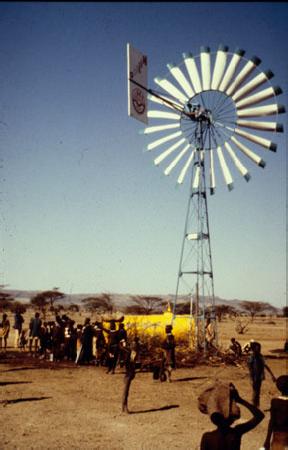A wind energy conversion system (WECS),[1] or wind energy harvester[2] is a machine that, powered by the energy of the wind, generates mechanical energy that can be used to directly power machinery (mill, pump,...) or to power an electrical generator for making electricity.[3] The term can thus refer to windmills, windpumps as well as wind turbines.
Operation[edit | edit source]
The conversion of the energy of the wind into more useful forms can be done using a rotor fitted with blades or sails. Note that a suitable location needs to be chosen for the WECS, preferably an open area[4] Also, some general locations lend themselves far better than others for WECS. See Wind power
Windmills[edit | edit source]

The wind has been a significant source of power for centuries. Early windmills in China and Southeast Asia lifted water into rice fields. In Europe the windmill developed into an enormous structure, nearly the size of a small sailing ship, developing power in the range of 25 hp and higher, for use in grain grinding, drainage and a multiple of small industrial tasks. The first windmills in North America and the Caribbean were of this type. In the late 19th century, water pumping windmills were manufactured by the thousands, and several million machines were operated by the end of this century. These were mostly lifting water for farm houses and livestock.
Wind generators for electricity spread by the hundreds of thousands across rural North America in the 1930s supplying the farm houses with small amounts of power for radios and a few lights. Both the water pumping windmills and the wind generators went into decline with the coming of rural electrification, which offered cheap electricity for running electric pumps and many more household uses. With the energy crisis, however, sales of water pumping wind mills and wind generators have greatly increased in the United States.
It is the water pumping windmill that appears to be the most immediately relevant for rural energy needs in the developing countries, both for high value community water supplies and for irrigation pumping. Irrigation is the biggest single factor in improving farm yields, and there are many places where low-lift irrigation on small plots could be accomplished with windmills. Thailand, Greece, Japan, Peru, and Portugal are among the nations where significant numbers of irrigation windmills have been used in recent times. In North America, farmers built thousands of scrap wood waterpumping windmills before the manufactured steel machines appeared. In all of these national experiences, local windmill designs were developed to fit pumping needs, wind conditions, and materials available. These machines were built in small workshops; this kept prices low and repair skills nearby. In other countries where manufactured windmills have been directly introduced, the initial high cost and lack of repair skills have greatly reduced their attractiveness. (South Africa and Australia may be exceptions. In these industrialized countries, variations in the American fan-bladed windmill have been widely used to water livestock and isolated farmhouses. These are expensive high performance machines requiring infrequent but skilled maintenance and repair.)
Thus the historical record suggests that successful windmill promotion programs in developing countries will need to focus on locally adapted designs and craftsperson based production using local materials, with a limited number of manufactured parts. Promotion programs might include credit mechanisms whereby the windmill itself is both loan and collateral. Also of interest is the Las Gaviotas approach in which the buyer assembles and installs a metal windmill from a kit (see Un Molino de Viento Tropical).
Windpumps[edit | edit source]

A windpump is a windmill used for pumping water, either as a source of fresh water from wells, or for draining low-lying areas of land. Once a common fixture on farms in semi-arid areas, windpumps are still used today where electric power is not available or too expensive.
The first half of the 20th saw further development, particularly a move toward propeller type wind machines for electricity production. By the 1920's 6 million windpumps were being used in the USA alone and their manufacture and use had become commonplace on every continent.But the glory of the windpump was short-lived. With the advent of cheap fossil fuels in the 1950's and 1960's and the development of pumping technology the windpump became almost obsolete in the USA.
There are manufacturers in several developing countries now producing windpumps. The uptake of wind machines for water pumping, however, has been generally very slow even though the technology is well suited to the demand of many regions of Africa, Asia and Latin America.
Wind turbines[edit | edit source]
The most modern generations of windmills are more properly called wind turbines, or wind generators, and are primarily used to generate electricity and electrical energy. Modern windmills are designed to convert the energy of the wind into electricity. The largest wind turbines can generate up to 6MW of power (for comparison a modern fossil fuel power plant generates between 500 and 1,300MW).
With increasing environmental concern, and approaching limits to fossil fuel consumption, wind power has regained interest as a renewable energy source. It is increasingly becoming more useful and sufficient in providing energy for many areas of the world, especially in temperate climates.
Wind Turbine systems have a competitively high Energy Return on Investment (EROI) estimated to be around 36.5:1. (National Renewable Energy Laboratory)
To generate enough power for a family, the tower and the blades need to be sufficiently large. See Domestic energy consumption
Kite Systems[edit | edit source]
Kite systems convert the wind's kinetic energy to other forms of energy: mechanical energy, motion of mass, noise, electricity, potential energy, tension, heat, light. Kite systems convert the energy of the wind; such energy may be employed to do general works genera and practical works. Energy Kite Systems. A kite system consists of wings coupled with tensioned tethers interacting with a media, say air or water; the wing(s) of a kite system may be seen as anchors relative to each other.